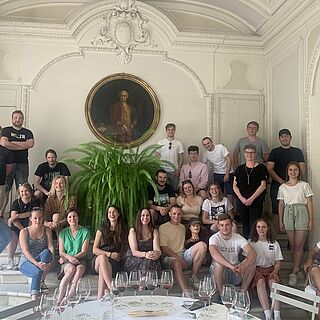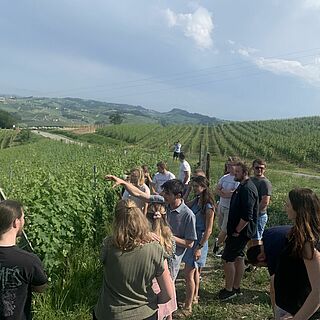Study excursion to Piedmont
After a two-year break due to the coronavirus, students from the Wine Campus were finally able to go on a major excursion again this year. This year, they went to Piedmont under the motto "Marketing strategies for the wine world". In particular, the students were to learn about examples of so-called "generic marketing" on the excursion. In generic marketing, the joint marketing of wine with typical regional products such as hazelnut specialties, regional food and exclusive fashion plays a special role. The group therefore also visited the University of Gastronomic Science in Piedmont. This university emerged from the "Slow Food Movement", which in turn was founded in Piedmont. Slow Food stands for enjoyable, conscious and regional food and describes a counter-movement to uniform and globalized fast food.
The Piedmont region has been known for its outstanding wine quality since the Middle Ages. In order to protect this high level of wine quality, the entire Piedmont region is included in the DOC classification. Up to 90% red grape varieties are cultivated on widely varying soils, although the white grape variety Moscato is also frequently found in southern areas. The Nebbiolo grape, which enjoys great international fame with its Barolo, is considered a particular flagship of Piedmont. Barolo is known as a strong red wine with a dense tannin structure, which means it can be stored for a wonderfully long time. Traditionally, the wine was stored in large chestnut or oak barrels after two months of maceration. Nowadays, emphasis is placed on a shorter maceration period after fermentation and ageing in barriques in order to achieve an earlier drinking maturity. Nevertheless, the name and production method of Barolo are protected. To be allowed to call a Nebbiolo wine Barolo, it must be aged for at least 38 months in the winery, of which at least 18 months should be in wood.
In order to familiarize the students with the topic of the excursion "Marketing strategies for the wine world", a wide range of different wineries were visited. From large cooperatives and wineries to small family-run businesses, the students were able to gain impressions of very different philosophies on the subject of wine. The itinerary also included big names such as the Marchesi di Barolo and Marchesi Alfieri wineries. In many wineries, the difficulty of holding on to the traditions of the region while at the same time adapting to the new conditions and innovations of modernity became clear. This dichotomy became particularly clear at the small biodynamic Rivetto winery, which is considered a pioneer of the sustainability debate in Piedmont, but at the same time, in his eyes, does not have the necessary leeway to break new innovative ground.
The trip not only focused on wine, it was also about examining marketing strategies from other sectors and learning from them in the wine industry. The students also visited an organically managed hazelnut plantation in Piedmont. There, the basic idea of organic farming was practiced in all areas of life and influenced the entire philosophy of life.
Finally, in Milan, the connection between the fashion world and the wine industry became visible in the form of a guided tour of Milan's fashion labels. The exclusivity and profile of the fashion companies, which have made their names known throughout the world through hard work over the years, was particularly impressive. In wine marketing, too, success can only be achieved through repeated, consistent high quality and the development of unique selling points.



